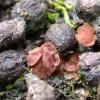
08-12-2025 17:37
 Lothar Krieglsteiner
Lothar Krieglsteiner
20.6.25, on branch of Abies infected and thickened

07-12-2025 16:07
Arnold BüschlenHallo, ich habe in einer Moos-Aufsammlung (epiohy

16-03-2014 22:00
Hello,I found this species a few months ago but ha

08-12-2025 13:39
Thomas Læssøehttps://svampe.databasen.org/observations/10572899

05-12-2025 17:33
 Bruno Coué
Bruno Coué
Bonjour, je serais heureux de recueillir votre avi

06-12-2025 00:19
 Viktorie Halasu
Viktorie Halasu
Hello, would anyone have this article, please? An
 salut a tous,
salut a tous,in case of an article about pseudombrophila bulbifera, i'm in search of informations concerning ecology and distribution. has anybody made collections of this rare taxa, one of only two pseudombrophila-species with globose spores?
if someone has the diagnose of boudiers ascophanus dentatus (Bull. Soc. Mycol. France 13) i would be very thankful!!
Cordialement
Dirk

schöner Fund. Hast du die Pseudombrophila Arbeit von van Brummelen?
Die Arbeit von Boudier findest du hier:
Du zweifelst wohl an deiner Bestimmung? Die beiden Arten unterscheiden
sich nur durch die Sporengröße (über 10 oder unter 10 µm für denutata) und Ps. bulbifera
soll ein Sclerotium habe, was ich bei meinen Fund aber auch nicht so recht
finden konnte.
Gruß Peter

Moyne G. 2008. Pseudombrophila bulbifera (E.J. Durand) Brumm. Un champignon coprophile peu commun. Bulletin mycologique et botanique Dauphiné-Savoie, 191, p. 45-49.

On article about coprophious mushrooms I'm always interested. One can not unfortunately have any magazines. The love of money is not enough there. ;-)
Best regards Peter
PS: Mistake on my part. I meant Nicolas. Nobody is perfect. ;-)
Rene your proposal is not bad either, which has everything you as a PDF, you can take in the computer.
Thank you Peter
Je vous adresse, en privé, à cause du poids, un scan de la publication de Brummelen, répondant à votre demande.
Je signale toutefois qu'il y a, dans ce genre, et contrairement à ce que vous avez indiqué, deux espèces qui possèdent des ascospores sphériques. la deuxième étant P. dentata, sur excréments de lapin !!
René

